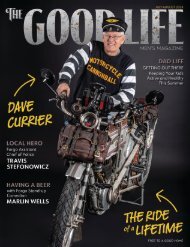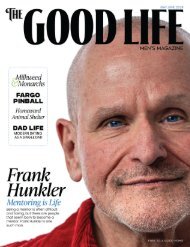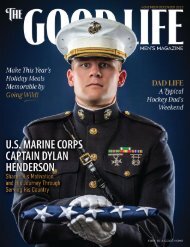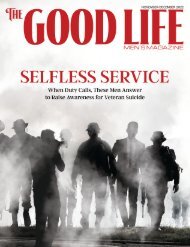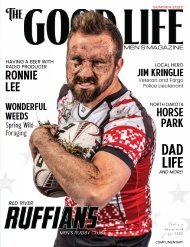The Good Life – March-April 2022
On the cover – Musician, Mike Morse. Local Hero and Veteran, John Dalziel. Also in this issue, Bass Fishing Tips from Jason Mitchell Outdoors, Kommer’s Custom Knives, Dad Life and more!
On the cover – Musician, Mike Morse. Local Hero and Veteran, John Dalziel. Also in this issue, Bass Fishing Tips from Jason Mitchell Outdoors, Kommer’s Custom Knives, Dad Life and more!
You also want an ePaper? Increase the reach of your titles
YUMPU automatically turns print PDFs into web optimized ePapers that Google loves.
DAD LIFE<br />
EIGHT THINGS MY DAD TAUGHT ME<br />
A short list of dad-isms and advice that I was taught<br />
and whether or not they are relevant to my life.<br />
WRITTEN BY: PAUL HANKEL<br />
It is my great hope that I, as a dad, am able to pass<br />
on some of the dad-isms that my dad imparted to<br />
me. Going beyond wearing cargo shorts and keeping a<br />
meticulous eye on the household thermostat, here are<br />
a few dad-isms I enjoy.<br />
Expand your flavor pallet.<br />
I, much like every other 30-something male, took<br />
up a new food habit during the lockdown. Instead of<br />
getting weirdly obsessive about sourdough bread or<br />
nightshade vegetables, I chose spices. Because of this,<br />
I now have a small spice market in my cupboards, with<br />
spices from every hipster spice company on Instagram.<br />
<strong>The</strong>re IS a flavor profile beyond garlic salt and allspice<br />
people. Explore!<br />
Buy local produce and meat.<br />
North Dakota has some of the best soils<br />
in the world. This means that our state<br />
can produce some of the best meat<br />
and vegetables out there. Growing up, I<br />
didn't have store-bought corn, potatoes,<br />
rhubarb, or dill until I was living on my<br />
own. This has stuck with me.<br />
You can sleep anywhere if you're tired<br />
enough.<br />
• In between flights at an airport: can and have<br />
overslept and missed a flight.<br />
• Watching my kid play video games: out cold.<br />
• Two beers deep and watching an east coast<br />
college football game at 9 pm: lights out.<br />
• Five minutes post-Thanksgiving meal: ZZZ's.<br />
• It's a male and family trait that I am happy to<br />
say that I inherited. I just wish my ten-yearold<br />
was showing early signs of exhibiting this<br />
trait.<br />
Charcoal is always better than<br />
propane.<br />
Grilling season is a mere two months away<br />
and that means it's the perfect time to remind<br />
everyone of Dad Law #3 on this list: when able,<br />
charcoal beats propane every single time.<br />
Time to grill, flavor, overall experience…it's<br />
just better.<br />
Don't be afraid to spend the extra dollar or two at local<br />
butcher shops and produce markets for local stuff. Not<br />
only is the quality much better, but you're also helping<br />
out our local and state economy.<br />
Unless you're getting a truck, buy<br />
foreign cars.<br />
As a bald eagle/American flag<br />
type guy, this was hard<br />
advice for me to take as<br />
I've aged. However, my dad<br />
had a Subaru Legacy over<br />
400,000 miles on it and no<br />
major mechanical issues, so it was extremely hard to<br />
argue with his point.<br />
Growing up I had a Subaru Outback Sport, two<br />
Subaru sedans, a Toyota Camry, two Subaru<br />
Foresters, and a Toyota Corolla. Needless to<br />
say, the ladies were impressed.<br />
<strong>The</strong>n, I decided that I was a red-blooded<br />
American and needed to drive some Americanmade<br />
steel. So I bought a Ford Explorer last<br />
fall. Sidenote: next to the Kia Telluride, the Ford<br />
Explorer is the most mom-SUV of all the mom-<br />
SUVs on the market today. However, my kid<br />
plays four sports so I thought I also needed the<br />
space.<br />
2 / THE GOOD LIFE / urbantoadmedia.com
Conveniently after I had purchased my Ford Explorer<br />
and driven it approximately 70 miles, the engine<br />
exploded.<br />
I was given a Toyota Rav 4 to drive for two months<br />
while it was fixed and loved every minute of it.<br />
Do with this advice what you will.<br />
You will never remember your kid's friends'<br />
names.<br />
I am wholly convinced that I would lose money if<br />
someone asked me to name even all of my nieces and<br />
nephews, much less all my son's friends' names. Factor<br />
in all his sports team's teammates and it's game over.<br />
This is most certainly not intentional. It more so stems<br />
from the fact that, once I hit my mid-thirties, my<br />
capacity for long-term memory items is limited to:<br />
<strong>The</strong> Office quotes, my kid's practice schedule, and the<br />
password to the app that keeps all of my passwords in<br />
one place.<br />
Teaching your child to drive will be one of<br />
the scariest experiences of your life.<br />
While I have yet to face this nightmare (still thankfully<br />
five years away), I do have fond memories of my dad,<br />
on several occasions, taking the Lord's name in vain<br />
while teaching me to drive. To say that he aged slightly<br />
during those learning sessions in the parking lot of<br />
West Fargo High School during the summer of 2001<br />
would be the biggest understatement of all time.<br />
I feel it is only fair that I too experience the terror,<br />
optimism, and eventual expense of having a miniature<br />
version of myself on the roads. Can't wait.<br />
Invest in a snowblower.<br />
Two half-hearted Peloton sessions per week aren't<br />
going to keep you in good enough shape to be moving<br />
around piles of heavy, wet North Dakota snow, October<br />
through <strong>March</strong>.<br />
Don't fight the urge to save a few shekels by continuing<br />
to shovel the snow yourself…get a snowblower. Your<br />
lower back will thank you! •<br />
urbantoadmedia.com / THE GOOD LIFE / 3
CONTENTS<br />
VOLUME 9 | ISSUE 5<br />
MARCH-APRIL <strong>2022</strong><br />
02<br />
DAD LIFE - EIGHT THINGS MY DAD<br />
TAUGHT ME<br />
14<br />
NINE LIFESAVING MNEMONICS<br />
EVERY MAN SHOULD KNOW<br />
A short list of dad-isms and advice that I<br />
was taught and whether or not they are<br />
relevant to my life.<br />
24<br />
NORTH WOODS HEARTY POT ROAST<br />
RECIPE<br />
06<br />
10<br />
EARLY SEASON SMALLMOUTH BASS<br />
Late spring and early summer can be such<br />
a tremendous time to target smallmouth<br />
because early season smallmouth are often<br />
shallow and relatively easy to catch.<br />
HAVING A BEER WITH - Adam Ladwig<br />
KVRR News Anchor and Producer Adam<br />
Ladwig tells us a little about himself—like<br />
how he loves traveling and inflatable lawn<br />
decorations. Read on to learn more about<br />
the Colorado native.<br />
26<br />
30<br />
Cook up this hearty pot roast with braised<br />
beef shoulder roast and chunky fresh<br />
vegetables in a savory gravy.<br />
KOMMER'S CUSTOM KNIVES<br />
Custom knives made locally to fit in the<br />
palm of your hand.<br />
LOCAL HERO - John Dalziel<br />
After the 1983 bombings in Beirut, John<br />
Dalziel’s life changed forever, but his<br />
purpose became clear: he would serve and<br />
protect, no matter the cost.<br />
18<br />
ON THE COVER - Mike Morse<br />
Local musician talks about life and recovery<br />
ahead of his upcoming solo album release.<br />
4 / THE GOOD LIFE / urbantoadmedia.com
PUBLISHED BY<br />
Urban Toad Media LLP<br />
www.urbantoadmedia.com<br />
OWNER / GRAPHIC DESIGNER<br />
Dawn Siewert<br />
dawn@urbantoadmedia.com<br />
OWNER / PHOTOGRAPHER<br />
Darren Losee<br />
darren@urbantoadmedia.com<br />
CONTRIBUTING WRITERS<br />
Meghan Feir<br />
Paul Hankel<br />
Brett & Kate McKay<br />
Jason Mitchell<br />
Krissy Ness<br />
Emma Vatnsdal<br />
ADVERTISING INQUIRIES<br />
Dawn Siewert<br />
dawn@urbantoadmedia.com<br />
READ A PAST ISSUE<br />
yumpu.com/user/thegoodlife<br />
FOLLOW US ON FACEBOOK<br />
facebook.com/urbantoadmedia<br />
FOLLOW US ON TWITTER<br />
@urbantoadmedia<br />
FOLLOW US ON INSTAGRAM<br />
@urbantoadmedia<br />
SCAN ME<br />
<strong>The</strong> <strong>Good</strong> <strong>Life</strong> Men’s Magazine is distributed six times a year by<br />
Urban Toad Media LLP. Material may not be reproduced without<br />
permission. <strong>The</strong> <strong>Good</strong> <strong>Life</strong> Men’s Magazine accepts no liability for<br />
reader dissatisfaction arising from content in this publication. <strong>The</strong><br />
opinions expressed, or advice given, are the views of individual<br />
writers or advertisers and do not necessarily represent the views or<br />
policies of <strong>The</strong> <strong>Good</strong> <strong>Life</strong> Men’s Magazine.<br />
urbantoadmedia.com / THE GOOD LIFE / 5
EARLY SEASON<br />
SMALLMOUTH BASS<br />
WRITTEN BY: JASON MITCHELL OUTDOORS<br />
PHOTOS BY: JASON MITCHELL OUTDOORS<br />
6 / THE GOOD LIFE / urbantoadmedia.com<br />
Smallmouth bass are one<br />
of my favorite fish to target.<br />
Smallmouth bass are just built<br />
to provide joy and excitement.<br />
Much has been written and said<br />
about the fight of a smallmouth.<br />
<strong>The</strong> stubborn digging below the<br />
boat and airborne acrobatics<br />
simply make these fish so much<br />
fun to target and catch. Late<br />
spring and early summer can be<br />
such a tremendous time to target<br />
smallmouth because early season<br />
smallmouth are often shallow<br />
and relatively easy to catch.<br />
Smallmouth bass will typically<br />
spawn when the water<br />
temperatures reach the low<br />
sixties in the early season but fish<br />
will move shallow long before.<br />
Stable and warming water temps<br />
often create tremendous shallow<br />
water fishing opportunities. Cold<br />
fronts will often momentarily<br />
push fish off these shallow<br />
locations but only temporarily.<br />
Smallmouths typically look for<br />
rock, boulder and gravel locations<br />
in which to bed. Reefs and<br />
shorelines that offer this rock<br />
rubble bottom are prime. If I had<br />
to pick a perfect location to find<br />
shallow smallmouth in the spring,<br />
that location would be a large<br />
shallow flat or reef that protrudes<br />
from the shoreline where there<br />
are scattered rocks that range
Suspending jerk baits like<br />
the Salmo Rattling Sting<br />
are absolutely deadly on<br />
spring smallmouth bass<br />
in shallow water. Simply<br />
snap these lures one to<br />
three times in a cadence<br />
and then momentarily<br />
stall the lure.<br />
between the size of a baseball<br />
to the size of a bowling ball.<br />
Larger boulders scattered in<br />
the mix are alright and the<br />
entire reef doesn't necessarily<br />
have to be covered with rock<br />
but you can bet that the rock<br />
areas are the sweet spots.<br />
Obviously, large spots can hold<br />
more fish and attract more<br />
attention from anglers as well.<br />
Some of my favorite locations<br />
that often get overlooked or<br />
missed by other anglers are<br />
simply shallow rock spines<br />
that are slightly offshore,<br />
perhaps a hundred yards. <strong>The</strong><br />
closer to shore these locations<br />
are, the easier these locations<br />
are for other anglers to find. Of<br />
course, you can always catch<br />
fish on the easy-to-find obvious<br />
locations depending on the<br />
amount of fishing pressure but<br />
missed and overlooked is often<br />
better for cooperative fish in<br />
today's world.<br />
Polarized glasses are a<br />
must for reading water and<br />
side imaging can also help<br />
immensely. To really maximize<br />
the potential of side imaging,<br />
I often like to search through<br />
an area with my bow mount<br />
trolling motor down and lift<br />
my outboard motor so I get a<br />
better reading off both sides<br />
of the transducer. When I see<br />
patches of rock or boulders,<br />
I then move the crosshairs to<br />
mark those locations with a<br />
waypoint. You can bump fish<br />
off a location if you move too<br />
close but the fish typically<br />
return so if you have to get<br />
your boat right on top of a<br />
location to really learn the<br />
spot, do what you have to do<br />
to understand what you are<br />
fishing.<br />
For simply covering water<br />
and fishing through locations<br />
relatively fast, jerk baits like<br />
the Salmo Rattling Sting<br />
are simply deadly. <strong>The</strong> lures<br />
have a long cast weight<br />
transfer system that allows<br />
for launching casts which is<br />
important early in the year<br />
when you must be able to<br />
reach spots and cover water.<br />
Snapping the rod forward will<br />
cause the lure to slash and<br />
careen in opposite directions<br />
but the pause or stop between<br />
the snapping cadence is often<br />
what triggers strikes. If I could<br />
pick just one hard lure for<br />
springtime smallmouths… my<br />
vote would be a jerk bait.<br />
One change we have seen<br />
however on some fisheries<br />
is the move deeper by<br />
bedding bass. This seems<br />
to correlate with angling<br />
pressure. On heavily fished<br />
water, we are seeing more<br />
bass bedding in much deeper<br />
water. Depending on the lake,<br />
these deeper locations are<br />
often seven to fifteen feet of<br />
water. This is where deeper<br />
diving crankbaits and even<br />
some square bills can really<br />
shine especially if the fish<br />
are scattered and there are<br />
numerous locations along<br />
a shoreline that all have the<br />
potential to hold fish. Salmo<br />
Rattling Hornets in both the<br />
5.5 and 6.5 sizes can be deadly<br />
along with Square Bills.<br />
urbantoadmedia.com / THE GOOD LIFE / 7
Soft baits like flukes<br />
can be very effective<br />
on smallmouth bass in<br />
shallow water and are<br />
particularly effective in<br />
ultra-clear water or after<br />
cold front conditions.<br />
<strong>The</strong>re are times however when<br />
soft baits shine particularly<br />
with extremely clear water or<br />
post-frontal conditions that cool<br />
down water temps. My favorite<br />
all-time plastic for early season<br />
smallmouth in shallow water<br />
would have to be a fluke-style<br />
plastic. Flukes can be fished slowly<br />
unweighted or fished faster like<br />
a jerk bait by simply rigging on<br />
a darter head. You can also drop<br />
shot flukes particularly if you are<br />
fishing over deeper ten to fifteenfoot<br />
locations offshore.<br />
I haven't mentioned color yet but<br />
usually early in the year; location,<br />
depth and speed are so much more<br />
important. In other words, if you<br />
find fish, you usually can catch<br />
them and often with a variety of<br />
8 / THE GOOD LIFE / urbantoadmedia.com
presentations. <strong>The</strong>se fish<br />
are often triggered to react<br />
out of aggression. Don't be<br />
consumed with matching<br />
the hatch but do focus on<br />
being visible. I usually vary<br />
from the basic white to dark<br />
spectrum. White and pearl<br />
can be great colors as can<br />
be black, pumpkinseed and<br />
motor oil. Crayfish patterns<br />
always seem to produce but<br />
these fish often strike out<br />
of annoyance. Simply get<br />
lures in front of fish.<br />
Spend time to really dissect<br />
locations and learn spots.<br />
Always try to learn spots<br />
and fish from a comfortable<br />
distance. If you can see fish,<br />
these are often the toughest<br />
fish to catch. Try to back<br />
off far enough where<br />
seeing the fish is difficult.<br />
If the water is ultra-clear<br />
and the fish are difficult,<br />
what I have done with<br />
great success is running<br />
my boat around the area<br />
with my big motor to churn<br />
up and stain some of the<br />
water, often just making a<br />
pass back and forth idling<br />
upwind of the fish. This will<br />
sometimes cloud up the<br />
water just enough where<br />
the fish are not as spooked<br />
and discriminating on the<br />
presentation.<br />
urbantoadmedia.com / THE GOOD LIFE / 9
HAVING A BEER WITH | ADAM LADWIG<br />
HAVING A BEER WITH<br />
Adam Ladwig<br />
WRITTEN BY: MEGHAN FEIR<br />
PHOTOS BY: URBAN TOAD MEDIA<br />
Adam Ladwig, an Emmy Awardwinning<br />
news anchor and<br />
producer for KVRR-TV, met<br />
with us for a couple of brews at<br />
Drekker on a regular, blustery<br />
Tuesday in Fargo.<br />
After graduating from the<br />
University of Colorado, the news<br />
anchor started his professional<br />
life in Scottsbluff, Neb. Ladwig<br />
soon made the move to Devils<br />
Lake, N.D., to start a job as the<br />
bureau reporter for WDAZ, and<br />
four years later, he moved to<br />
Fargo to work as a weekend news<br />
anchor for KVRR.<br />
In 2016, Ladwig and his coanchor<br />
Emily Welker started the<br />
KVRR local morning news show<br />
that runs weekdays from 7-9 a.m.<br />
It’s a show he loves to be a part of,<br />
even if he’s still not used to getting<br />
up at 2 in the morning.<br />
<strong>Good</strong> <strong>Life</strong>: Adam, where in<br />
Colorado did you grow up?<br />
Adam Ladwig: I was raised in<br />
Morrison, Col., a suburb of Denver.<br />
It’s 10-15 minutes away from Red<br />
Rocks Amphitheater. In fact, my<br />
high school graduation ceremony<br />
was at Red Rocks. It was great<br />
because I was in the choir and we<br />
got to sing and hang out on stage<br />
throughout the ceremony. I always<br />
tell people I got to perform where<br />
the Beatles performed.<br />
10 / THE GOOD LIFE / urbantoadmedia.com
GL: What’s your opinion on lawn decorations?<br />
AL: What’s wrong with lawn decorations?<br />
GL: Are you a fan or are you against lawn decor?<br />
AL: I love them. I love being weird and expressing yourself, and if you want<br />
to have crazy lawn decorations and a whole team of lawn gnomes, go ahead.<br />
I go running sometimes by Gooseberry Park in Moorhead and there’s a<br />
house that has dozens of bowling balls lined up around the yard. I love<br />
running by that house.<br />
GL: Do you have lawn decorations?<br />
AL: If I had a big lawn I would. I got a bee-on-a-spring lawn decoration<br />
from a grab bag at a gift shop and planted it in the little yard by my building<br />
without telling anyone. I think someone took it out when they had to mow<br />
the yard and it didn’t get put back.<br />
GL: What about huge, inflatable Christmas decorations?<br />
AL: I love them!<br />
GL: Do you? Okay.<br />
AL: I would love to have a 10-foot tall inflatable of Baby Yoda wearing a<br />
Santa hat for Christmas.<br />
“I got a<br />
bee-on-a-spring<br />
lawn decoration<br />
from a grab bag<br />
at a gift shop<br />
and planted it in<br />
the little yard by my<br />
building without<br />
telling anyone.”<br />
GL: If you won the lottery for $1 million, what would you do with it?<br />
AL: Number one: Pay off student loans. Number two: I would probably use<br />
it to travel as much as I could. It would be so much fun to take trips to every<br />
corner of the world and explore different cultures and areas.<br />
urbantoadmedia.com / THE GOOD LIFE / 11
HAVING A BEER WITH | ADAM LADWIG<br />
“Living the good life is<br />
doing what makes you<br />
happy but also knowing<br />
what makes you happy,<br />
which I think is one of<br />
the hardest things to<br />
figure out in life.”<br />
GL: What’s been your favorite trip<br />
you’ve ever been on?<br />
AL: Oh, easy. I went to Iceland<br />
last summer. It was my first trip<br />
overseas and my first time in<br />
Europe. <strong>The</strong> natural beauty there<br />
made it seem like a different<br />
planet. <strong>The</strong> whole island is made<br />
of volcanic rock, so even walking<br />
along the ground looks completely<br />
different than here in the U.S.<br />
<strong>The</strong>y have these breathtaking<br />
waterfalls that are fed by glaciers<br />
and beaches with black sand.<br />
<strong>The</strong>re was a volcano eruption<br />
while I was there and I got to see<br />
the lava. It wasn’t exploding lava,<br />
but I could see smoke shooting out<br />
of the volcano and got to hike up<br />
to it. It stopped flowing two days<br />
after I saw it. <strong>The</strong>re hadn’t been<br />
an eruption in that peninsula of<br />
Iceland since the 1200s.<br />
GL: Where do you think you’d<br />
want to go next?<br />
AL: My girlfriend and I would<br />
both love to go to Ireland with<br />
their rolling, green hills and old<br />
12 / THE GOOD LIFE / urbantoadmedia.com<br />
castles and stuff. We just watched<br />
a Netflix Christmas movie that<br />
was set in Ireland called “<strong>The</strong><br />
Christmas Castle.”<br />
GL: Ahh, I love Hallmark-like<br />
movies.<br />
AL: Those movies are fun and<br />
cheesy, and if they’re bad you can<br />
make fun of them together. It’s<br />
not something you should feel<br />
ashamed of enjoying. I watch a<br />
bunch of them with my girlfriend.<br />
GL: I watched one set in Ireland<br />
too. It’s the one where this lady<br />
works for a management company<br />
out of New York—<br />
AL: That’s about half of them.<br />
GL: It’s always an executive who<br />
ends up realizing the joys of<br />
bucolic bliss.<br />
AL: Or her hometown.<br />
GL: Yes! I love those movies<br />
because they aren’t full of any<br />
actual, intense stress. It’s always,<br />
“Oh, no! How are we going to get<br />
everything ready in time for our<br />
Christmas festival!?”<br />
AL: Or the hunky lumberjack,<br />
whom she hated when they first<br />
met, will help save the day and<br />
they’ll fall in love and have one dry<br />
kiss at the end.<br />
GL: Speaking of Hallmark-like<br />
movies, if you could write a<br />
Hallmark movie that you and<br />
Kelly were going to star in, what<br />
would it be about?<br />
AL: She’s a small-town florist,<br />
and I am a curmudgeon news<br />
anchor who has to do some story<br />
on Christmas flowers but is<br />
grumbling the whole time because<br />
he just doesn’t understand the<br />
point of flowers for Christmas.<br />
GL: And you hate poinsettias.<br />
AL: Yes, and we argue over how<br />
to say it. And then we storm off in<br />
separate directions. She’s also part<br />
of the old church in town. It needs<br />
renovations or else it’s going to be<br />
foreclosed on. She has to organize<br />
some benefit to save it and needs<br />
the help of the TV station to get<br />
the word out. I end up helping out<br />
and get into the spirit of things,<br />
and the next thing I know I’m<br />
hanging up garland on the wall
and decorating the tree.<br />
GL: And then your heart melts.<br />
AL: And it grows three sizes that day.<br />
GL: And then you share a dry kiss at<br />
the end.<br />
AL: Exactly! And live happily ever<br />
after.<br />
GL: What animal would you be?<br />
AL: Maybe a buffalo. You’re just<br />
hanging around, eating whenever<br />
you want, not really causing too<br />
much mischief. But if someone<br />
really, really gets you mad, you’re not<br />
fun to mess with.<br />
GL: What would be one thing you’d<br />
change about this country?<br />
AL: Is this the “gotcha” question?<br />
GL: I’m going to make you look real<br />
bad. Just kidding.<br />
AL: I wish that fewer things would<br />
get politicized. It seems like no<br />
matter what anyone says about<br />
anything, it invites some sort of<br />
backlash and argument. It’s really<br />
hard to say something benign. In<br />
the last few years, everything has<br />
become a statement on something.<br />
It’s exhausting.<br />
GL: What does living “the good life”<br />
mean to you?<br />
AL: Living the good life is doing what<br />
makes you happy but also knowing<br />
what makes you happy, which I think<br />
is one of the hardest things to figure<br />
out in life. Maybe it’s not a thing<br />
you’re doing, like a job, but a mindset<br />
you have. Something stuck with me<br />
the day of my college graduation. I<br />
was talking with my mom and said<br />
something along the lines of, “Now I<br />
need to figure out what I want to do<br />
with my life.” She looked at me and<br />
said, “Honey, I still don’t know what I<br />
want to do with my life. It’s okay.” •<br />
urbantoadmedia.com / THE GOOD LIFE / 13
NINE LIFESAVING MNEMONICS<br />
EVERY MAN SHOULD KNOW<br />
WRITTEN BY: BRETT & KATE MCKAY / ARTOFMANLINESS.COM<br />
When it comes to trying to save a life — either someone<br />
else’s or your own — it can be hard to remember what<br />
to do. Not only because the breadth of survival/first aid<br />
know-how is so vast, but because it’s hard to think clearly<br />
in a threatening situation.<br />
That’s where mnemonics — the use of rhymes, acronyms,<br />
and other techniques to more easily remember something<br />
— come in handy. For example, you likely conjure up<br />
the cardinal directions by saying “Never Eat Shredded<br />
Wheat,” remember the colors of the rainbow by thinking<br />
of that colorful fellow ROY G. BIV, and remind yourself<br />
to avoid touching poison ivy by rehearsing the old “leaves<br />
of three, let them be” admonition.<br />
Below are 9 mnemonics related to first aid and survival<br />
that can be easily memorized now, and readily pulled out<br />
in case of emergency later:<br />
To identify venomous snakes:<br />
Red on yellow, kill a fellow;<br />
red on black, friend of Jack<br />
This classic rhyme is a help in differentiating venomous<br />
coral snakes from similar looking but nonvenomous king<br />
snakes. <strong>The</strong> former sport alternating black, yellow, and<br />
red bands of color in which the red and yellow stripes<br />
touch each other; a king snake has the same bands of<br />
color but in a different pattern, so that the red stripes<br />
touch the black.<br />
It’s important to keep in mind that this mnemonic<br />
only holds true for North America; other species of<br />
coral snakes exist outside the continent with different<br />
markings. One should also keep in mind that king snakes<br />
are not exactly a “friend” in the sense that you’d want to<br />
handle them; even if nonvenomous, they can still bite,<br />
and snakebites of any kind aren’t pleasant.<br />
How to recognize if someone is having a heart attack: PULSE<br />
14 / THE GOOD LIFE / urbantoadmedia.com<br />
Pain in the chest, jaw, neck, back, or arms<br />
Upset stomach (nausea, vomiting, indigestion)<br />
Lightheadedness (or dizziness)<br />
Shortness of breath<br />
Excessive sweating<br />
<strong>The</strong> hour after a heart attack happens is referred to as the “golden<br />
hour,” as the sooner a victim can get medical treatment, the better the<br />
chance of mitigating the irreversible, tissue-killing damage that follows<br />
in its wake. As another popular phrase in the medical community goes,<br />
“time is muscle,” so know the signs of a heart attack well and familiarize<br />
yourself with what to do in case one occurs.
To recognize if someone is having a stroke: FAST<br />
Face drooping<br />
Arm weakness<br />
Speech slurring<br />
Time to call 9-1-1, if you see these symptoms<br />
Just as with a heart attack, every minute counts when<br />
someone has a stroke, and the sooner you recognize one<br />
is happening, and seek medical attention, the better the<br />
chance of survival and of preventing long-term disability.<br />
To save someone from drowning: Reach, Throw, Row, Go<br />
If you see someone drowning (which can be harder to<br />
recognize than you think), your first instinct is likely to<br />
jump into the water to save them. But this actually isn’t<br />
the best course of action; drowning people aren’t only<br />
a danger to themselves, but to their would-be rescuer;<br />
panicked and flailing about, they can pull and push you<br />
under when you’re trying to help.<br />
It’s thus better to avoid entering the water if possible<br />
and to follow the options for action in the order of this<br />
mnemonic: If the victim is close to the shoreline, reach a<br />
pole or branch to them; if they’re too far out to be reached<br />
with that kind of object, throw a rope or safety ring to<br />
them; if they’re too far away to rescue with these first<br />
two methods, row (or motor, killing the engine as you<br />
approach) a boat to get closer, and then reach, throw, or<br />
lift them from inside the watercraft; if the victim cannot<br />
be reached by pole, rope, or boat, or is unconscious/<br />
distressed and thus unable to grab a flotation device,<br />
only then should you go into the water. Someone availing<br />
themselves to this final option should be a strong<br />
swimmer trained in lifesaving techniques.<br />
urbantoadmedia.com / THE GOOD LIFE / 15
To predict a coming storm: Red sky at night, sailor’s delight;<br />
red sky in morning, sailors take warning<br />
Referring to the orange-red glow which appears at<br />
sunrise/sunset, this saying is so old and famous a<br />
variation of it is quoted by Jesus in the book of Matthew.<br />
A red night sky can mean that a high-pressure system<br />
(which brings clear weather) is moving in, or has moved<br />
in, from the west. This weather system traps particles in<br />
the air, which scatters the blue light of the sun, creating<br />
the reddish glow.<br />
A red sky in morning can signify that a high-pressure<br />
system is moving towards the east and a low-pressure<br />
system (which can bring wind, rain, and storms) is<br />
moving in from the west.<br />
This rule of thumb is most correct when you’re positioned<br />
at middle latitudes. Air quality and pollution can also<br />
skew things some.<br />
To effectively use a fire extinguisher: PASS<br />
Pull the pin in the handle<br />
Aim at the base of the fire<br />
Squeeze the trigger<br />
Sweep across the fire<br />
You’ve see fire extinguishers around so often, it’s easy to believe you’d just naturally<br />
know how to use one should the need arise. But while extinguishers are indeed<br />
fairly simple in design, it’s the kind of thing you can fumble around with in the<br />
literal heat of the moment. It’s thus worth familiarizing yourself with when and<br />
how to use one; the PASS acronym can help you remember the basics.<br />
To survive a bear attack:<br />
If it’s brown, lie down;<br />
if it’s black, fight back<br />
How you should respond to a bear attack depends on the<br />
kind of bear you’re dealing with.<br />
With a brown/grizzly bear, fighting back will often<br />
increase the ferocity of the attack, so you instead want<br />
to play dead, lying still with your stomach on the ground,<br />
and your hands protecting the back of your neck.<br />
With a black bear, you want to stand your ground,<br />
making yourself look as big and imposing as possible,<br />
and fighting back with blows to its face and muzzle.<br />
16 / THE GOOD LIFE / urbantoadmedia.com<br />
To collect yourself when lost: STOP<br />
Stop where you are<br />
Think about your situation<br />
Observe what is around you<br />
Plan your next actions<br />
When you’re lost, it can be easy to work yourself into<br />
a panic that only makes your situation worse. Instead,<br />
you want to STOP, which begins with literally stopping<br />
where you are (tell kids to “hug a tree”), as staying put<br />
can actually help you get found/back on track better<br />
than frenetically moving further and further afield.<br />
After you sit down, you want do some thinking — about<br />
when you first realized you were lost, what resources
for navigation/survival you have at<br />
your disposal, etc. <strong>The</strong>n you observe<br />
— seeing what in your environment<br />
might point you in the right direction<br />
or be used to send out a distress<br />
signal, and looking at a map to orient<br />
yourself. Finally, you formulate a<br />
plan, deciding whether you think you<br />
can retrace your steps or it’s better<br />
to stay put, and what your survival<br />
priorities are (see below) and how to<br />
obtain them.<br />
To assess your survival<br />
priorities: RULE OF THREES<br />
3 hours without shelter<br />
(depending on environmental<br />
conditions)<br />
3 days without water<br />
3 weeks without food<br />
In a survival situation, you have basic<br />
needs that have to be met to stay alive,<br />
but each is not equally urgent, and<br />
you want to prioritize the allocation<br />
of your energies appropriately: first<br />
getting out of extreme heat/cold; then<br />
finding a source of water; and finally<br />
figuring out how to find food.<br />
<strong>The</strong> fact that you can survive 3<br />
minutes without air is also sometimes<br />
thrown into the “Rule of Threes”<br />
mnemonic, but of course that only<br />
applies should you find yourself<br />
choking or underwater! •<br />
urbantoadmedia.com / THE GOOD LIFE / 17
ON THE COVER | MIKE MORSE<br />
WRITTEN BY: EMMA VATNSDAL<br />
PHOTOS BY: URBAN TOAD MEDIA<br />
<strong>Life</strong> takes us in many different directions.<br />
For West Fargo musician Mike Morse, life has taken<br />
him from central Montana, across the U.S., across the<br />
world and back to Fargo.<br />
He's played at hundreds of small town bars in the<br />
upper Midwest, and is releasing his first album near<br />
the end of February.<br />
But this life hasn't always been so easy.<br />
"I started out really, really young," said Morse. "I stole<br />
my sister's guitar at about age 7 or 8, hid it in a hay<br />
fort, and learned how to play it. I took a few lessons,<br />
and before you know it, I'm on a school bus traveling<br />
the country with a bunch of guys that are 20 years<br />
older than me, playing rock and roll."<br />
Morse says, early on, his career choice wasn't exactly<br />
the path his parents would have chosen for him.<br />
"My dad is a retired microbiology professor, mom's a<br />
retired eighth-grade school teacher, and when I said<br />
'Oh, I'm going on the road in a rock band' they're like<br />
'no you're not.' It took some convincing, but sooner or<br />
later they're just like 'go'.<br />
Morse's talent took him all across the globe; from<br />
USO tours to Japan, Guam and Europe, to shows<br />
across the United States.<br />
But fame sometimes does come with a price.<br />
"My first gig, I was 13," said Morse. "And (the<br />
bartenders') main goal was to see how drunk they<br />
could get me. And I spent the next five or six years in<br />
18 / THE GOOD LIFE / urbantoadmedia.com
urbantoadmedia.com / THE GOOD LIFE / 19
ON THE COVER | MIKE MORSE<br />
the bottom of a bottle. To the point of throwing up blood, you know,<br />
bad, just bad."<br />
By his 22nd birthday, Morse had already been to treatment — that<br />
was seven years prior, at age 15, but the lifestyle he was living just<br />
wasn't conducive to sobriety.<br />
"I had this cool house gig in Kalispell, Mont.," said Morse. "I had<br />
the most killer gig in the state of Montana at the most cool place<br />
on Flathead lake. My landlord came over with a pint. We finished<br />
that off, I went to work, had a double shot at six bar stations at the<br />
bar I worked at, I did all of those and they brought me a shot after<br />
every other song."<br />
He eventually passed out on stage.<br />
"<strong>The</strong> reason I remember when I decided I was going to quit<br />
drinking," he said. "I woke up the next day and I had like 50 people<br />
at my house for a party, I could not get my head off the kitchen floor<br />
because that was the only cool place I could find to lay. And I'm like<br />
'I'm done. I'm never drinking again.'"<br />
20 / THE GOOD LIFE / urbantoadmedia.com
That was <strong>March</strong> 6, 1991. "And I haven't touched a drop<br />
since."<br />
THERAPY<br />
For some alcoholics, the first go at quitting is rarely the<br />
last go. Couple that with a career in music that requires<br />
playing gigs at bars night in and night out, and it can be<br />
difficult to stay on the wagon.<br />
But nearly 31 years later, Morse has<br />
stayed on the wagon.<br />
"I mean your job is at the bar," he<br />
said. "And your job is partying with<br />
these people. But it's like, yeah, it's<br />
my therapy. I watch these people<br />
night in and night out and it's a<br />
constant mirror, reflector for me. So<br />
that's the way I look at it anyway. A<br />
lot of people can't look at it that way, I get that, but it's all<br />
about your mindset and how you perceive it. I was just<br />
ready to quit, I was done."<br />
Alcohol wasn't the only substance he struggled with over<br />
the years. However, he remains sober of all substances to<br />
this day.<br />
"I DID A TOTAL 180 FLIP<br />
TO COUNTRY," HE SAID.<br />
"AND I'VE BEEN PLAYING<br />
THAT EVER SINCE."<br />
<strong>–</strong> MIKE MORSE<br />
"I don't know if I just grew up or what, but now I kind of<br />
reflect that energy back into my music now," he said. "I<br />
mean I'm on to the next EP already. Actually, I'm on to the<br />
one after that. <strong>The</strong> next one is already written."<br />
SMALL TOWNS ON TWO LANES<br />
In the early '90s, Morse's art took a twangy turn.<br />
"I did a total 180 flip to country," he<br />
said. "And I've been playing that ever<br />
since."<br />
He's played, and lived, in nearly every<br />
region of the United States, until<br />
1996 when he wound up in Fargo,<br />
N.D.<br />
"I moved here from Texas," Morse<br />
said. "With 147 inches of snow,<br />
driving a Camaro — which was not fun."<br />
He left for a few years, before coming back to Fargo to be<br />
with his girlfriend, now wife.<br />
Morse played in a few bands around the Fargo-Moorhead<br />
area before sticking with one for 16 years.<br />
urbantoadmedia.com / THE GOOD LIFE / 21
ON THE COVER | MIKE MORSE<br />
"<strong>The</strong>n the pandemic hit," said Morse. "And I was<br />
playing in my basement to the internet and then the<br />
band, they never came back."<br />
One thing led to another and soon Morse was on his<br />
way to Nashville to record his first solo album.<br />
"I don't write songs about drinking," he said. "I mean,<br />
I can't really. I have to write songs that are real to me,<br />
real life experiences, and that's not part of me."<br />
Morse's first album as a solo artist was released at<br />
the end of February. He says the songs are inspired<br />
by the small communities he's been able to play at in<br />
his years of music.<br />
"<strong>The</strong>re's a song (on the album) that says, 'It's a little<br />
bit of hustle, a whole lot of chase. It's where you find<br />
humble, it's where leather meets lace.' Because,<br />
I mean, it really is. Rural America is not that easy<br />
anymore. Everything seems to be geared towards<br />
the city, but the real, honest, good stuff, to me, it's<br />
out there. <strong>The</strong>y don't sugar coat it."<br />
<strong>The</strong> album is a love letter to rural America and the<br />
places and things he's seen at the end of those two<br />
lanes.<br />
"<strong>The</strong> funnest times I've had are those little Harvey,<br />
N.D., or Lake Ashtabula, N.D., or Webster, S,D.,"<br />
said Morse, "Those are where I have the most<br />
fun and where they really appreciate it more than<br />
just playing where you're just kind of background<br />
music."<br />
But there's one song that is sure to pull at the<br />
heartstrings and cause listeners to reach for their<br />
tissues.<br />
"I lost my parents a few years ago," he said. "My<br />
mom was diagnosed with fast liver cancer. I mean,<br />
when they called me, they said they gave her 14<br />
days. She died 13 days later. But when my mom<br />
died, she told my dad to go through all her personal<br />
stuff and get rid of it. So he did. And he went home<br />
and started going through her chest of drawers, and<br />
in the very bottom drawer, tucked inside a sweater,<br />
were all the love letters that he had written my mom<br />
in college."<br />
Morse was given the same instructions that his<br />
mom had given his dad.<br />
"He said, 'When I die, I want you to go back through<br />
22 / THE GOOD LIFE / urbantoadmedia.com
my stuff, cherish the memories but I want you to get<br />
rid of this stuff.' And I did, and sure enough in the<br />
bottom drawer there were those letters."<br />
He toyed with what to do with the letters for quite<br />
some time, and on the day of his father's funeral, he<br />
said his good-byes and stuck the letters inside the<br />
pocket of his dad's suit to be buried with him.<br />
"So there's a song on there called '<strong>The</strong> Letters' that's<br />
all about that."<br />
And when it comes to <strong>The</strong> <strong>Good</strong> <strong>Life</strong>, Morse says he<br />
is living it.<br />
"<strong>The</strong> <strong>Good</strong> <strong>Life</strong> is being able to do what you wanted<br />
to do and not feeling like it's work," he said. "Even<br />
though it's bust ass. I'd rather die, starving, being<br />
happy doing what I'm doing than have all the riches<br />
in the world and hate it."<br />
You can find Morse all across the upper Midwest —<br />
dates and locations on his website mikemorselive.<br />
com.<br />
Find Morse's music on iTunes, Spotify, Amazon,<br />
Pandora, or wherever you find your music. •<br />
urbantoadmedia.com / THE GOOD LIFE / 23
north woodS<br />
HEArTY POT rOAsT<br />
Cook up this hearty pot roast with braised beef shoulder roast and chunky fresh<br />
vegetables in a savory gravy.<br />
24 / THE GOOD LIFE / urbantoadmedia.com
COURTESY OF BEEFITSWHATSFORDINNER.COM<br />
INGREDIENTS:<br />
• 1 beef shoulder roast boneless (2 to 2-1/2 pounds)<br />
• 1 tablespoon vegetable oil<br />
• 1/2 teaspoon salt<br />
• 1 pound small red-skinned potatoes, cut in half, or into<br />
quarters if large<br />
• 4 medium carrots, cut into 2-1/2 x 1/2- inch pieces<br />
• 2 medium parsnips, cut into 2-1/2 x 1/2-inch pieces<br />
• 1 small leek, (white and pale green parts only), cut in half<br />
lengthwise then crosswise into 1-1/2 inch pieces<br />
• 1 cup beef broth<br />
• 4 tablespoons water<br />
• 2 tablespoons cornstarch<br />
SEASONING<br />
• 2 teaspoons seasoned pepper blend or garlic-pepper<br />
seasoning<br />
• 1 tablespoon minced garlic<br />
COOKING<br />
1. Combine seasoning ingredients; press evenly onto all<br />
surfaces beef shoulder roast boneless. Heat oil in stockpot<br />
over medium heat until hot. Brown roast on all sides. Pour off<br />
drippings and season beef with salt.<br />
2. Add broth to stockpot; bring to a boil. Reduce heat; cover<br />
tightly and simmer 2 hours. Add vegetables; continue cooking,<br />
covered, 30 to 45 minutes or until roast and vegetables are<br />
fork-tender.<br />
3. Remove roast and vegetables; keep warm. Strain cooking<br />
liquid; skim fat, if necessary. Measure 2 cups cooking liquid<br />
(Add beef broth or water to cooking liquid to yield 2 cups, if<br />
necessary.); return to stockpot. Combine water and cornstarch;<br />
stir into cooking liquid. Bring to boil, stirring constantly; cook<br />
and stir 1 to 2 minutes or until mixture is thickened.<br />
4. Carve roast into thin slices. Season with salt, as desired.<br />
Serve with vegetables and gravy.<br />
TEST KITCHEN TIPS<br />
Cook until fork-tender. When fork can be<br />
inserted without resistance and releases<br />
easily when pulled out, the beef is done.<br />
urbantoadmedia.com / THE GOOD LIFE / 25
KOMMERS '<br />
Custom Knives<br />
WRITTEN BY: KRISSY NESS<br />
PHOTOS BY: URBAN TOAD MEDIA<br />
Whenever I think about how to make a knife, my mind<br />
wanders to a factory churning out knife after knife. But, while<br />
that may be how production knives get made, it couldn't be<br />
further from the truth for Kommer's Custom Knives.<br />
Russ Kommer is a native of Minnesota, but he spent many<br />
years living in Alaska. He is an avid hunter, which drew him<br />
to Alaska. "I was a hunting guide for many years, and one of<br />
the hunters had this couple thousand dollar knife on his belt,<br />
and it made me so mad," laughed Kommer. "I was out there<br />
making a living with a rifle and a knife, and I couldn't afford<br />
it." That's when he began making his own.<br />
For the past 25 years, Kommer has been making custom<br />
folding knives, fixed knives, fighting hawks, hatchets, and<br />
fancy kitchen knives. Twenty of those years, he worked out of<br />
his shop just outside of Fargo, N.D., and continues today.<br />
"I used to design for many companies, but then I retired," said<br />
Kommer. "I still do some designing for Columbia Knife and<br />
Tool, Fox America, Fox Italy, and my custom work."<br />
Kommer has made knives for Special Ops men and women,<br />
hunters, anglers, and your everyday folding knife. "I make<br />
everything from a wedding cake knife to a double-edged<br />
fighter knife for our military guys," said Kommer. "<strong>The</strong>re<br />
is a purpose for every knife, and not every knife will do<br />
everything."<br />
Creating a knife is not something you can rush; it can take 40<br />
hours to a thousand hours. "People ask me how long it takes<br />
to make a knife, and I don't know, mainly because I don't want<br />
to know," joked Kommer. "I would probably not be making<br />
knives if I kept track."<br />
26 / THE GOOD LIFE / urbantoadmedia.com
urbantoadmedia.com / THE GOOD LIFE / 27
From start to finish,<br />
Kommer is precise<br />
and obsessive when it<br />
comes to the quality and<br />
look of each knife. His custom<br />
work is so exact that he requires<br />
tracing the individual's hand to ensure<br />
the fit is accurate and comfortable. Next, he<br />
draws a pattern and cuts that into Plexiglas. <strong>The</strong>n,<br />
the countless hours of grinding the knife into shape,<br />
placing the handle, and buffing and sharpening the piece<br />
take place. <strong>The</strong> finished product is always impressive and<br />
sought after.<br />
"I had a knife this fall that I had made, and this guy<br />
wanted it, he kept asking for it, and I told him I would<br />
make him one, but he just wanted that one; so needless<br />
to say - he got it," laughed Kommer. "If you want to sell a<br />
knife, wear it on your belt."<br />
Kommer is most known for his hunting knives, "I do a lot<br />
of hunting, so I like to make those kinds of knives," said<br />
Kommer. "It's my bread and butter."<br />
You can buy any knife off the shelf, but there is something<br />
exceptional about getting one made especially for you.<br />
“<strong>The</strong>re is a purpose for every<br />
knife, and not every knife will do<br />
everything." <strong>–</strong> Russ Kommer<br />
28 / THE GOOD LIFE / urbantoadmedia.com
"For some guys, the most precious<br />
thing they have is their custom<br />
knife," exclaimed Kommer. "It's<br />
personal."<br />
<strong>The</strong> passion for creating runs in<br />
Kommer's family. His nine-year-old<br />
granddaughter is known to help<br />
him around the shop. She even<br />
helped him design a production<br />
knife. "She drew a pattern on the<br />
back of a school project and gave it<br />
to me; then we modified it a bunch<br />
and I made it."<br />
To have the patience and detailed<br />
eye to create such beautiful pieces<br />
is something to admire. It is no<br />
wonder people are literally trying to<br />
buy the knife right off his belt.<br />
"Every time I got out with a knife<br />
on my belt, everyone says, 'Man, I<br />
want Russ's knife,'" Kommer said.<br />
"That's why I'm building myself<br />
a knife right now because I gave<br />
mine away."<br />
If you want to buy a custom knife<br />
from Kommer, you'll have to wait<br />
your turn, the waitlist is at least a<br />
year out, but it is definitely worth<br />
the wait. •<br />
urbantoadmedia.com / THE GOOD LIFE / 29
LOCAL HERO | JOHN DALZIEL<br />
30 / THE GOOD LIFE / urbantoadmedia.com
WRITTEN BY: MEGHAN FEIR<br />
PHOTOS BY: URBAN TOAD MEDIA<br />
<strong>Life</strong> can completely change in the blink of an eye.<br />
One moment your life is familiar, but a split second<br />
later, that familiarity feels a million miles away.<br />
During his 4 years in the United States Marine<br />
Corps, John Dalziel was deployed in Germany,<br />
Norway, Denmark and Honduras. But it wasn’t<br />
until he was deployed to Beirut that his life turned<br />
upside down.<br />
Oct. 23, 1983 seemed like a normal Sunday<br />
morning when Dalziel got out of bed, left to<br />
grab a cup of coffee and see some friends before<br />
getting to work. After visiting with a friend<br />
inside the barracks, he headed toward the 24th<br />
Marine Amphibious Unit Headquarters. Dalziel<br />
had walked about 200 yards from the barracks<br />
when a Mercedes truck housing 21,000 pounds<br />
of explosives went off in the headquarters of the<br />
U.S. 8th Marine Regiment’s 1st Battalion. Minutes<br />
later, another truck bomb took out the French<br />
barracks nearby.<br />
PHOTOS SUBMITTED BY: JOHN DALZIEL<br />
<strong>The</strong> catastrophes, claimed by Hezbollah, stole<br />
hundreds of lives. <strong>The</strong>y resulted in the deaths of<br />
241 U.S. military personnel, 58 French military<br />
personnel, and six civilians. More than 100 others<br />
were injured. Of the 241 U.S. military personnel,<br />
220 were Marines, 18 were Navy sailors and three<br />
were Army soldiers. This harrowing tragedy was<br />
the highest death toll in Marine Corps history<br />
since World War II.<br />
Had Dalziel not left the barracks 10 minutes<br />
before, he would have been counted among the<br />
lost.<br />
urbantoadmedia.com / THE GOOD LIFE / 31
LOCAL HERO | JOHN DALZIEL<br />
PHOTOS SUBMITTED BY: JOHN DALZIEL <strong>–</strong> IMAGES L-R: 1 JOHN DALZIEL - USMC BOOTCAMP, 1981. 2 HIS FATHER, ROD DALZIEL - USMC.<br />
3 SITE OF BLT BOMBING - NEAR BEIRUT INTERNATIONAL AIRPORT.<br />
“Everybody has that one defining moment. Beirut has<br />
been a pivot point for me on everything in my life,”<br />
Dalziel said. “<strong>The</strong> day we got blown up in Beirut was<br />
that defining moment that keeps coming around.<br />
It turned me into the man I became, the principles I<br />
adhere to. I just always keep coming back to the good<br />
and the bad.”<br />
Since that life-changing experience, some clarity<br />
emerged from the fog of devastation. From losing close<br />
friends and brothers in arms to dealing with the trauma<br />
it created for him and so many others, the bombings<br />
that caused so much pain also produced in Dalziel a<br />
resolute sense of purpose and commitment to serve<br />
and protect others from harm’s way.<br />
But for years, his commitment never seemed like<br />
adequate restitution. No matter how hard he worked, it<br />
didn’t heal the pain of losing so many comrades.<br />
A PIECE OF THE BARRACKS THAT HOUSED THE 1ST<br />
BATTALION 8TH MARINES THAT WAS BOMBED AT THE BEIRUT<br />
INTERNATIONAL AIRPORT ON 23 OCT 1983 KILLING 241.<br />
“Why did I survive? Why did I walk out of the building<br />
10 minutes before it got blown up? Why did I survive<br />
when my friends and brothers in arms didn’t?” Dalziel<br />
said. “I just always kept coming back to Beirut.”<br />
DEALING WITH THE DEMONS<br />
From birth, Dalziel was taught Marine Corps morals.<br />
His father, Rod, was a former Marine and made sure his<br />
three boys and daughter knew life was about service.<br />
This prompted Dalziel and his two brothers to join the<br />
Marine Corps.<br />
“We volunteered, were in the Boy Scouts, did stuff for<br />
church—it was all about volunteering and giving back,”<br />
Dalziel said. “I come from a family of service.”<br />
While his family, friends and he have willingly risked<br />
everything for the good of their country, service often<br />
comes with a price. <strong>The</strong> trauma experienced after<br />
witnessing the horrors of violence, suffering, war<br />
and death often catapult many service members into<br />
struggles with survivor guilt and post-traumatic stress<br />
disorder (PTSD), two things Dalziel struggled with for<br />
years.<br />
“Prior to deploying to Iraq and Afghanistan, a part of<br />
me was like, ‘I hope I die there. I hope that I’m able<br />
to give the ultimate sacrifice to pay for the guys that<br />
died that Sunday morning,’” Dalziel said. “When I was<br />
struggling early on, I would lock myself up in a room<br />
because I didn’t want my wife and two boys to have to<br />
experience that. But at the end of the day, they still did<br />
because they were being shut off or I was being short. It<br />
caused more damage than if I would have just realized<br />
that it was an issue early on and just talked to them<br />
about it, but I didn’t.”<br />
32 / THE GOOD LIFE / urbantoadmedia.com
PHOTO SUBMITTED BY: JOHN DALZIEL <strong>–</strong> BALA HISSAR FORT - AFGHANISTAN.<br />
<strong>The</strong> survivor guilt, immense stress, nightmares,<br />
flashbacks and pain experienced by Dalziel and other<br />
service members are not uncommon. In a 2017 study<br />
involving 5,826 U.S. veterans, 12.9 percent were<br />
diagnosed with PTSD. In another study done in 2014,<br />
87 percent of 3,157 U.S. veterans had been exposed to<br />
at least one potentially traumatizing event.<br />
PTSD is often paired with depression, putting PTSD<br />
sufferers at a higher risk of committing suicide. <strong>The</strong><br />
Defense Suicide Prevention Office also states other<br />
risk factors, such as substance use, other mental health<br />
conditions, and relationship problems.<br />
According to the 2021 National Veteran Suicide<br />
Prevention Annual Report by the Office of Mental<br />
Health and Suicide Prevention, there was an average of<br />
17.2 veteran suicides per day in 2019.<br />
“I’ve had two really good friends who have committed<br />
suicide. One of my buddies committed suicide in 2017.<br />
He was in Army Special Forces, was a true American<br />
hero and had done multiple deployments. He had a wife<br />
and five kids, but he just couldn’t deal with the demons,”<br />
Dalziel said. “In 2021, one of my other close friends,<br />
Bruce Bennett, a former Marine, LA County Sheriff's<br />
Deputy and retired FBI Special Agent, took his own<br />
life.”<br />
Unable to fight their way out of the pain by themselves,<br />
highly trained service members often place more<br />
shame on their shoulders. Although PTSD is common<br />
among military service members, stigmas still prevent<br />
many sufferers from seeking help. Whether they’re<br />
worried they will be seen as “weak” or “crazy,” unable<br />
to perform regular tasks, or a danger to the very society<br />
they protected, the guilt, shame and affliction can be too<br />
hard for many to bear.<br />
After years of seeking help, Dalziel said that while<br />
he still gets occasional flashbacks, his PTSD and his<br />
management of it have improved greatly.<br />
“Every now and then I’ll have moments when you talk<br />
to somebody, you hear that song, or you get that smell<br />
in your nose,” Dalziel said, “but once a month we do<br />
hero workouts with a group of guys and gals who get<br />
together to talk about those who have paid the ultimate<br />
sacrifice. It’s helped me move forward because we’re<br />
keeping their spirit alive. You die twice; you die once<br />
when your body dies, and you die a second time when<br />
people quit talking about you.”<br />
To honor his friends and brothers in arms, Dalziel joined<br />
the Brady Oberg Legacy Foundation in 2017, as an<br />
ambassador for the mission, assisting in coordinating<br />
events and reaching out to veterans to show them<br />
they’re not alone.<br />
“I’m trying to do things to honor them and to get people<br />
to realize that there is help out there. It’s not a battle you<br />
have to fight for yourself.”<br />
urbantoadmedia.com / THE GOOD LIFE / 33
LOCAL HERO | JOHN DALZIEL<br />
PHOTOS SUBMITTED BY: JOHN DALZIEL <strong>–</strong> IMAGES L-R:<br />
1 FLAGPOLES WITH MEMORIAL. 2 MARINES AT THE MEMORIAL<br />
- US EMBASSY BEIRUT. 3 GENERAL MATTIS AND ALAT DALZIEL.<br />
While working with the FBI, Dalziel went overseas to<br />
Iraq and Afghanistan several times before setting foot<br />
on familiar soil yet again.<br />
In 2011, Dalziel willingly went back to Lebanon after<br />
being selected as the assistant legal attache at the U.S.<br />
Embassy in Beirut.<br />
NO MATTER THE COST<br />
After the devastation of the bombings, Dalziel’s<br />
purpose was clear: He needed to continue serving and<br />
protecting, no matter the cost. He went back to Beirut<br />
for the pull-out in 1984 before going to college to enter<br />
law enforcement.<br />
Dalziel worked for South Dakota’s Division of Criminal<br />
Investigation for 7 years before joining the FBI as a<br />
special agent. He was first assigned to the Chicago<br />
Division, and in late 1998 he was transferred to the<br />
Fargo Resident Agency. Besides working 18 months<br />
at FBI Headquarters and having several overseas<br />
deployments, Dalziel spent the majority of his 21 years<br />
in North Dakota.<br />
“When you tell people you’re in the FBI in North<br />
Dakota, their first question is, ‘<strong>The</strong>re’s an FBI in North<br />
Dakota?’” he said.<br />
Dalziel worked on some high-profile cases during<br />
his time with the FBI, including the Dennis Gaede<br />
and Timothy Wicks case involving stolen identity and<br />
murder.<br />
“I went back to try to get some closure and retribution<br />
for what they, Hezbollah, did to the 241 of my brothers<br />
who died. I wanted closure,” Dalziel said. “On Oct. 23,<br />
2011, at 6:22 a.m., I was on the site of the bombing<br />
again. It was a surreal moment. You have a flashback<br />
to 1983, but it continues forward through time and how<br />
that single event has influenced those of us who have<br />
survived to protect, serve and keep going.”<br />
Dalziel was there for a year working with the Lebanese<br />
Internal Security Forces coordinating investigations of<br />
interest to both Lebanon and the U.S., but he also found<br />
time to complete another mission: convincing the U.S.<br />
ambassador to erect a Marine Corps flag right next to<br />
the American flag outside of the embassy.<br />
“I reached out to a few of my friends and put some<br />
money together to have the pole constructed,” Dalziel<br />
said. “Beirut is the only embassy in the world where<br />
the Marine Corps flag is flown 24 hours a day, 7 days<br />
a week.”<br />
Today, a memorial wall and the Marine Corps flag hang<br />
proudly in the U.S. Embassy in Beirut to pay tribute<br />
to the 241 marines who died in the 1983 bombing.<br />
Gen. James Mattis, the commanding general of the<br />
U.S. Central Command at the time, came to give the<br />
dedication.<br />
In 2016, Dalziel found himself in Beirut once more<br />
34 / THE GOOD LIFE / urbantoadmedia.com
after being asked by the Marine<br />
Corps to be the guest speaker for<br />
the 241st Marine Corps Birthday<br />
Ball, the first ball since 1982,<br />
before the bombing.<br />
STANDING READY<br />
Like so many others and their<br />
families, Dalziel and his family<br />
have made immense sacrifices so<br />
he can follow his calling. He has<br />
missed out on special, everyday<br />
moments with his wife and two<br />
boys, his sons’ sporting events,<br />
family crises and celebrations in<br />
order to help ensure the safety<br />
and freedom of his family, friends,<br />
Americans and people worldwide.<br />
“<strong>The</strong> things we accomplished in<br />
Beirut, Iraq and Afghanistan are<br />
all a reflection of the total of the<br />
group effort. It’s all been for the<br />
purpose that without order there<br />
is chaos,” Dalziel said. “With what<br />
we’re doing with the Brady Oberg<br />
Legacy Foundation and veteran<br />
suicide—it all comes together<br />
through that one pivot point that<br />
Sunday morning in Beirut.”<br />
When asked what living the good<br />
life means to Dalziel, he simply<br />
stated a quote often attributed to<br />
George Orwell, Winston Churchill<br />
and Richard Grenier: “Men sleep<br />
peacefully in their beds at night<br />
because rough men stand ready to<br />
do violence on their behalf.” •<br />
urbantoadmedia.com / THE GOOD LIFE / 35




